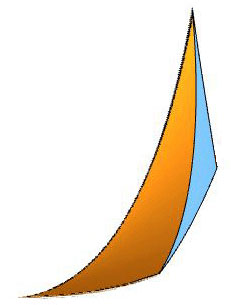Generalisations of Smooth Structures

Infinitely-differentiable (or smooth) structures on manifolds are a successful generalisation of real analysis on taking advantage of the fact that many properties and constructs used in the theories of differentiation and integation are local in nature, or at least can be constructed locally and put together to achieve a global entity. One major drawback, however, is that differentiability requires no singularities, and is finite-dimensional. But singularities show up naturally in subspaces and quotients of and manifolds (think of a cone with its apex), and function spaces are infinite-dimensional, and we often need to do calculus on these. And so, it is necessary to introduce a notion of differentiability on these more general types of spaces.
There are two common perspectives on this: by constructing a smooth structure on a set using things that map out of so a family of functions, a sheaf, or some kind of ring/algebra; and using things that map in to so a family of curves, or a generalisation of an atlas in which the charts go into instead of out of It turns out that the former are better for obtaining subspace invariants, and so you see these used a lot in the study of, say, real algebraic varieties, whereas the latter are better for obtaining quotient invariants, and so come up in the study of equivariant situations. So which one to use? It depends on what one needs to do. But if one is looking for an overall category that includes both perspectives, then one needs to consider a set equipped with both types of structures.
The first best attempt at accommodating both perspectives is that of Frölicher spaces: sets equipped with a family of curves and a family of real-valued functions such that if and only if for every , we have is smooth in the usual sense; and if and only if for every , we have is smooth in the usual sense. This category naturally contains, for example, manifolds-with-corners, real algebraic varieties, as well as function spaces. However, it has some drawbacks: it cannot tell the difference between, for example, the manifold-with-boundary and where acts on by reflection. As another example, it cannot tell the difference between and . Perhaps the user is fine with this, or perhaps they need a category that allows for stronger invariants.
Another solution is to consider the category of pairs of differential structures and diffeological structures. Without going into too much detail, the definition of an object in this category is very similar to that of a Frö'licher space, except that we replace with a family of maps from open subsets of any Euclidean space (no fixed dimension), and we only ask that for and the composition be infinitely-differentiable. There is no need for one family to determine the other. This category can distinguish between the examples in the previous paragraph.
One can push for even stronger invariants, but very quickly one finds themselves in the realm of higher categories, such as that of Lie groupoids and stacks, or schemes. These are fine, but it may be worth knowing what exactly the more concrete categories get you first before jumping into a much larger and more complicated environment such as these.
A good reference for some of this is my thesis [W:PhD] and a paper written with experts on diffeological, differential, and Frölicher spaces [BIZKW]. More in this direction is to come!
- [BKW] Augustin Batubenge, Yael Karshon, and Jordan Watts, Diffeological, Frölicher, and differential spaces, Rocky Mountain J. Math., 55(3) (2025), 637-670.
- [W:PhD] Jordan Watts, Diffeologies, Differential Spaces, and Symplectic Geometry, PhD Thesis, Department of Mathematics, University of Toronto, 2012.